*NURSING > EXAM > NURSING 101/Chapter 9. Nursing Care of Patients in Shock My Nursing Test Banks,100% CORRECT (All)
NURSING 101/Chapter 9. Nursing Care of Patients in Shock My Nursing Test Banks,100% CORRECT
Document Content and Description Below
NURSING 101/Chapter 9. Nursing Care of Patients in Shock My Nursing Test Banks Chapter 9. Nursing Care of Patients in Shock Multiple Choice Identify the choice that best completes the statement or ... answers the question. 1. A patient with gastrointestinal bleeding is awake, alert, and oriented and has vital sign measurements of: blood pressure 130/90 mm Hg, pulse 118 beats/minute, respirations 18/minute, and temperature 98.6F (37C). Which finding should the nurse consider as a possible sign of early shock? a. Respirations 18/min b. Heart rate 118 beats/min c. Temperature 98.6F (37C) d. Blood pressure 130/90 mm Hg 2. A patient with gastrointestinal bleeding has hemoglobin of 8.5 g/dL. While receiving care the patient becomes anxious and irritable and bright red drainage appears through the nasogastric tube. The patients vital signmeasurements are pulse 130 beats/minute, blood pressure 105/55 mm Hg, and respirations 28/minute. What should the nurse recognize as causing the changes in the patients vital signs? a. Early shock b. Patient anxiety c. Progressive shock d. Parasympathetic response 3. A patient involved in a motor vehicle accident has pale mucous membranes, diaphoresis, confusion, blood pressure 88/48 mm Hg, irregular heart rhythm, and metabolic acidosis. Which finding should the nurse recognize as the likely cause of acidosis? a. Hyperventilation b. Aerobic metabolism c. Inadequate ventilation d. Anaerobic metabolism 4. A patient with progressive shock is diaphoretic and confused. The most recent blood pressure measurement was 82/40 mm Hg and a urinary catheter output was 10 mL for 1 hour. Intravenous (IV) fluids are infusing at 150 mL/hr. Which action should the nurse take related to the urine output? a. Encourage oral fluids. b. Irrigate urinary catheter. c. Increase IV fluid infusion rate. d. Check urinary catheter for kinking. 5. A patient with hypovolemic shock is experiencing oliguria due to hemorrhage. Which should the nurse recognize as the most likely cause of the patients oliguria? a. End-stage renal failure b. Secretion of aldosterone c. Inadequate oral fluid intake d. Obstructed urinary catheter 6. On arrival in the emergency department, a patient who was in a motor vehicle accident is apprehensive, confused, and hypotensive. The patient has tachycardia, oliguria, and cool clammy skin. What should the nurse do first? a. Cover patient with warm blankets. b. Perform a rapid head-to-toe assessment. c. Obtain patients medical history from family. d. Reorient the patient to person, place, and time. 7. A patient who is hemorrhaging has pale mucous membranes, blood pressure 92/52 mm Hg, pulse 160 beats/minute, and respirations 30/minute. The patient is receiving IV fluids at 150 mL/hour, has a blood transfusion infusing, and is being provided oxygen via a mask. What should the nurse recognize as the most likely cause of the patients respiratory rate? a. Electrolyte imbalances b. Inadequate tissue perfusion c. Rapid rate of fluid replacement d. Reaction to the blood transfusion 8. Despite aggressive treatment, the condition of a patient in shock continues to worsen. Surgical intervention stops the bleeding, and the shock stabilizes. Which finding should the nurse act upon immediately? a. The blood pH is 7.36. b. Bowel sounds are hypoactive. c. Urinary output is 15 mL/hour. d. Pupils are equally reactive to light. 9. After an episode of shock, a patients laboratory results reveal elevated serum levels of ammonia and bilirubin and decreased plasma proteins and clotting factors. Which organ should the nurse recognize as being damaged from the shock? a. Heart b. Liver c. Kidneys d. Intestines 10. After an episode of shock, a patients laboratory results reveal decreased clotting factors. Based on these laboratory results, the nurse should monitor for which complication of shock? a. Brain attack b. Multisystem organ failure c. Adult respiratory distress syndrome d. Disseminated intravascular coagulation 11. The family of a patient in shock asks the nurse to explain the condition. How should the nurse respond to this family? a. It is caused by massive blood loss. b. It is a profound circulatory collapse. c. It is the result of overwhelming emotion. d. There is inadequate oxygen delivered to the tissues. 12. A patient is demonstrating signs of anaphylactic shock. What action should the nurse take first? a. Provide pain relief. b. Ensure a patent airway. c. Provide patient teaching. d. Obtain a detailed patient history. 13. The nurse provides comfort measures to maintain normal body temperature and reduce pain and anxiety for a patient who is experiencing shock. What is the purpose of the nurse performing these actions? a. Increases fluid volume b. Decreases fluid volume c. Increases oxygen demand d. Decreases oxygen demand 14. The nurse is caring for a patient in mild shock. Which medication should the nurse question before providing if ordered for a patient experiencing shock? a. Benadryl b. Morphine c. Dopamine d. Solu-Medrol 15. A patient is receiving a dopamine infusion for shock. What should the nurse expect to assess in the patient because of this medication? a. Pain relief b. Decreased heart rate c. Increased blood pressure d. Increased respiratory rate 16. A patient is admitted with suspected septic shock. Which action should the nurse take first? a. Obtain patient temperature. b. Insert an IV access device. c. Determine if the patient has any medication allergies. d. Reassure the patient that everything possible will be done. 17. A patient recovering from vascular leg surgery is found standing in a large pool of blood flowing from the surgical site. After assisted into bed, the patient is pale with a palpable pulse. What action should the nurse take? a. Notify the charge nurse. b. Start an infusion of 0.9% NaCl. c. Apply oxygen at 2 L/min via nasal cannula. d. Elevate legs and apply pressure over the bleeding site. 18. A patient hemorrhaging from an incision has a blood pressure of 70/0 mm Hg. What type of fluid replacement should the nurse anticipate will be ordered initially? a. 0.9 % normal saline b. Fresh frozen plasma c. Packed red blood cells d. Lactated Ringers with 50 mL albumin 19. A patient is experiencing respiratory distress and mild shock. In which position should the nurse place the patient? a. Prone b. Head elevated c. Trendelenburg position d. Flat with elevated foot of bed 20. Data collection findings for a patient include shortness of breath with crackles in the lung bases, jugular vein distention, daily weight increased by 3 pounds from yesterday, report of chest pain, blood pressure 86/40 mm Hg, pulse 132 beats/minute, and respirations 30/minute. Which order should the nurse question? a. Electrocardiogram (ECG) STAT b. 500 mL 0.9% NS over 30 minutes c. Oxygen 2 L/min via nasal cannula d. Arterial blood gases (ABGs) STAT and repeat in 1 hour 21. A patient with a history of a myocardial infarction has chest pain. The patients skin color is grayish, blood pressure is 88/70 mm Hg, pulse is 116 beats/minute and irregular, and respirations are 30/minute. Which action should the nurse take? a. Place the patient supine. b. Notify the charge nurse. c. Check the urine specific gravity. d. Infuse 0.9% normal saline wide open. 22. The nurse discovers that a patient recovering from surgery is hemorrhaging from the incisional site. What action should the nurse take? a. Offer oral fluids. b. Warm the patient. c. Relieve the patients apprehension. d. Apply pressure to the bleeding site. 23. A patient who had surgery 3 days ago has a temperature of 98F (36.6C), blood pressure 82/72 mm Hg, pulse 120 beats/minute, and respirations 30/minute. Which type of shock should the nurse suspect is occurring in this patient? a. Septic b. Neurogenic c. Cardiogenic d. Hypovolemic 24. The nurse obtains vital signs on a patient with gastrointestinal bleeding who has a large, dark red, foul-smelling stool. Which vital sign changes should the nurse report as indicative of early shock? a. Normal blood pressure, tachycardia, and rapid respirations b. Rise in diastolic blood pressure, bradycardia, and slow respirations c. Decreasing systolic blood pressure, bradycardia, and slow respirations d. Drop in diastolic blood pressure, bradycardia, and shallow respirations 25. The spouse of a patient in neurogenic shock asks what is happening to the patient. How should the nurse response to the spouse? a. This is because of an allergic reaction. b. There is a drop in circulating blood volume. c. The heart has failed to pump blood throughout the body. d. The blood vessels have dilated and lowered the blood pressure. 26. Patients are being treated in the intensive care unit for anaphylactic, septic, and neurogenic shock. For which type of shock should the nurse plan to provide care? a. Obstructive b. Distributive c. Cardiogenic d. Hypovolemic 27. A patient in shock is diagnosed with metabolic acidosis. What should the nurse realize as being the mechanism behind the development of this acid- base imbalance? a. Excessive aerobic metabolism b. Excessive anaerobic metabolism c. Decreased anaerobic metabolism d. Release of cortisol and glucagon 28. The nurse is contributing to a staff education program about complications associated with urinary catheters. Which type of shock should the nurse recommend be included in the presentation? a. Septic b. Cardiogenic c. Anaphylactic d. Hypovolemic 29. As part of ongoing data collection and care of a patient in shock, the nurse notes a slowing heart rate, systolic blood pressure less than 60 mm Hg, a decreasing temperature, decreasing respiration rate, and scant urine output. These signs and symptoms should indicate to the nurse that the patient is in which stage of shock? a. Mild b. Severe c. Moderate d. Compensated 30. After collecting data, the nurse suspects that a patient is experiencing cardiogenic shock. Which finding supports this nurses suspicion? a. Oliguria b. Tachypnea c. Bronchospasm d. Pulmonary edema 31. The nurse is assisting in the planning of care for a patient in shock. Which nursing diagnoses should the nurse recommend be included in the patients plan of care? a. Hopelessness b. Risk for aspiration c. Excess fluid volume d. Inadequate tissue perfusion 32. The nurse is receiving report on patients assigned for the next shift. Which patient should the nurse observe first? a. A patient who has a pressure ulcer who is due for a dressing change b. A patient with diabetes who has a blood sugar of 85 and is eating lunch c. A patient with cellulitis who is receiving the first dose of IV antibiotics and who is reporting a feeling of tightness in the throat d. A patient with sickle cell anemia who is receiving a monthly transfusion of a unit of packed red blood cells who is reporting left knee pain 33. A patient is admitted for care because of heat stroke. Why should the nurse include interventions to prevent the onset of shock? a. The heat causes excessive dilation of veins and arteries. b. Inability to tolerate oral fluids could lead to more water lost. c. Parasympathetic stimulation causes blood to pool in the extremities. d. Excessive water lost through sweating can lead to hypovolemic shock. 34. The nurse is caring for an 85-year-old patient with septic shock. What should the nurse keep in mind when repositioning this patient? a. Change positions slowly. b. Reduce flow rate of oxygen. c. Increase flow rate of IV fluids. d. Place in Trendelenburg position. 35. The nurse is monitoring hourly urine output from an indwelling catheter for a patient experiencing hypovolemic shock. What should the nurse do if the patients urine output drops to 15 mL for one hour of monitoring? a. Document the finding. b. Flush the urinary catheter c. Clamp the catheter for 30 minutes. d. Immediately report the drop in urine output. 36. A patient in shock is found unresponsive. The nurse knows that immediate cardiopulmonary resuscitation is required because brain cells begin to die if deprived of oxygen for how many minutes? a. 1 b. 2 c. 4 d. 8 Multiple Response Identify one or more choices that best complete the statement or answer the question. 37. The nurse is monitoring a patient being for septic shock. Which findings indicate that the patient is improving? (Select all that apply.) a. SpO2 94% b. pH is 7.33 c. Pulse 75 beats/minute d. Temperature 101F (38.3C) e. Blood pressure 110/90 mm Hg f. Urine output less than 25 mL/hr 38. The nurse is assisting in the care of a patient with early signs and symptoms of shock. Which diagnostic tests should the nurse expect to be prescribed for this patient? (Select all that apply.) a. Urinalysis b. Chest x-ray c. Arterial blood gas d. Complete blood count e. Electroencephalogram (EEG) f. Blood type and crossmatch 39. A patient who is taking atenolol (Tenormin) is experiencing shock. Which symptom of shock should the nurse expected to be absent in this patient? a. Pulse 115 beats per minute b. Respirations 28 per minute c. Blood pressure 88/48 mm Hg d. Capillary refill greater than 3 seconds 40. A patient in shock has a falling blood pressure. What should the nurse realize occurs as the sympathetic nervous system responds to falling blood pressure? (Select all that apply.) a. Blood glucose levels increase. b. Sodium and water are retained. c. Less oxygen is delivered to tissues. d. Vasodilation leads to increased fluid loss. e. Epinephrine is released from the adrenal medulla. f. Blood is shunted away from the skin, kidneys, and intestines. 41. The nurse explains procedures and treatments while caring for a patient in shock. Why should the nurse provide these explanations to the patient? (Select all that apply.) a. Provide support b. Decrease anxiety c. Enhance learning d. Reduce the signs of shock e. Prevent future shock episodes 42. A patient is developing anaphylactic shock. What should the nurse expect to observe in this patient? (Select all that apply.) a. Polyuria b. Urticaria c. Bronchospasm d. Muscle cramps e. Laryngeal edema 43. The nurse is monitoring a patient who has been in a shock state for several days. For which serious complications should the nurse observe in the patient and then report? (Select all that apply.) a. Sepsis b. Malnutrition c. Diabetes mellitus d. Cerebrovascular accident e. Adult respiratory distress syndrome f. Multiple organ dysfunction syndrome 44. A patient in shock is being transported to the nearest emergency department. Upon arrival in which order should the nurse provide care? Place the actions in the order that they should be performed. a. Ensure breathing. b. Secure an airway. c. Assess level of consciousness. d. Prepare for x-rays and other tests. e. Apply pressure to bleeding wounds. f. Monitor heart rate and blood pressure. 45. The nurse determines that a patient with severely bleeding wounds does not have an adequate airway. What should the nurse do to help this patient? (Select all that apply.) a. Insert an oral airway. b. Insert a nasal airway. c. Apply 100% oxygen via face mask. d. Prepare for endotracheal intubation. e. Attempt the head tilt/chin lift method. 46. The nurse determines that a patient with hypovolemic shock is improving. What did the nurse observe to come to this conclusion? (Select all that apply.) a. Heart rate increasing b. Respiratory rate increasing c. Present of peripheral pulses d. Systolic blood pressure increasing e. Urine output 20 mL over the last hour [Show More]
Last updated: 1 year ago
Preview 1 out of 21 pages
Instant download
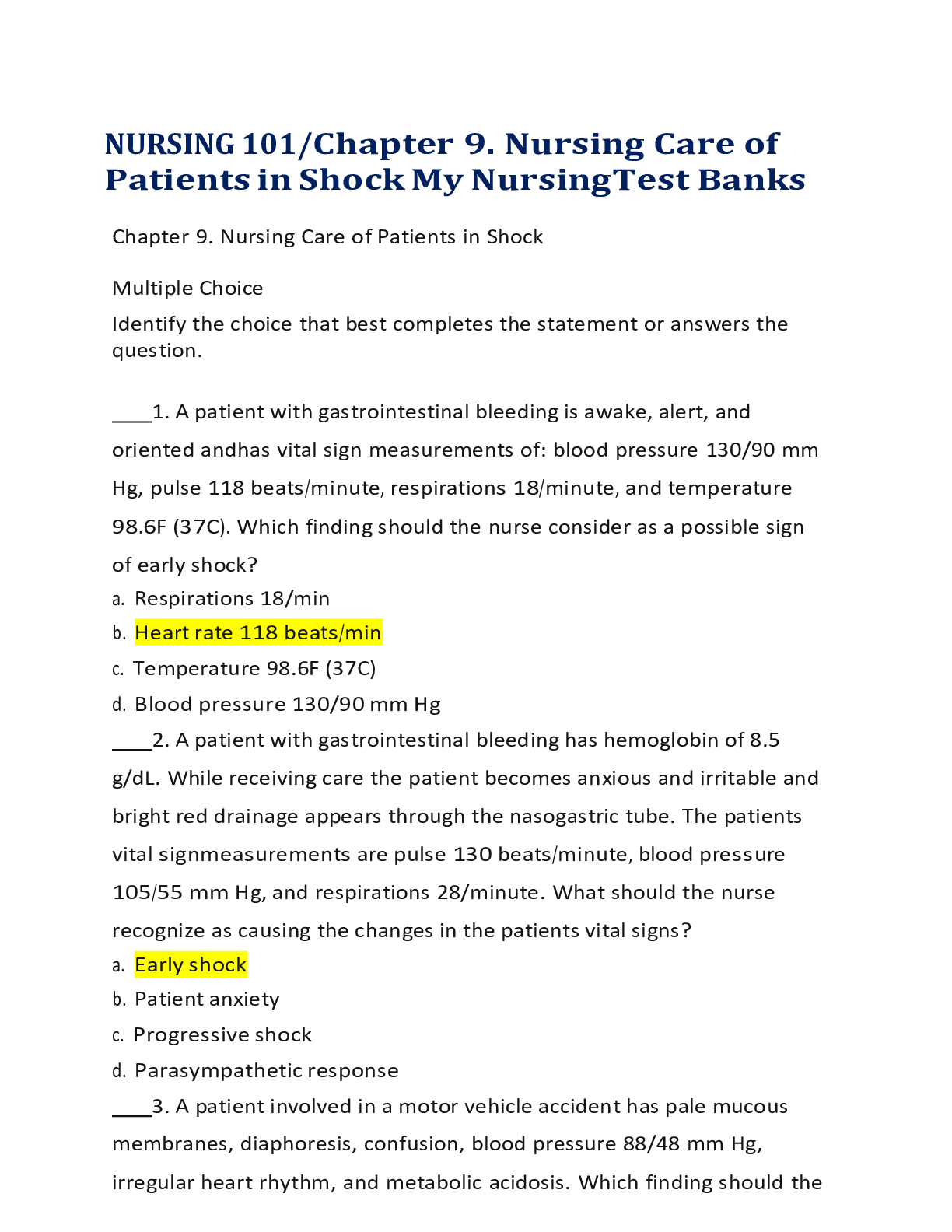
Buy this document to get the full access instantly
Instant Download Access after purchase
Add to cartInstant download
Reviews( 0 )
Document information
Connected school, study & course
About the document
Uploaded On
May 04, 2021
Number of pages
21
Written in
Additional information
This document has been written for:
Uploaded
May 04, 2021
Downloads
0
Views
30













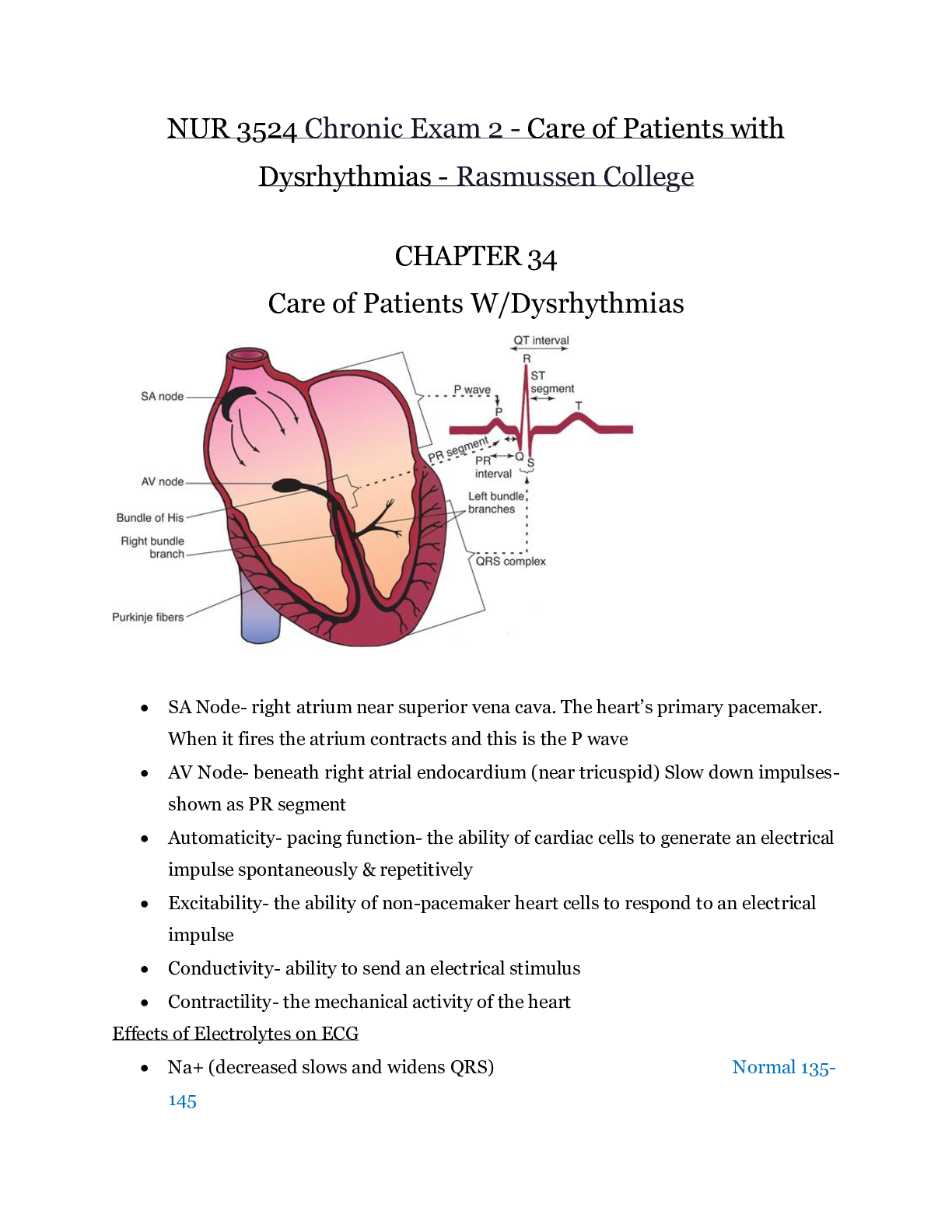


.png)
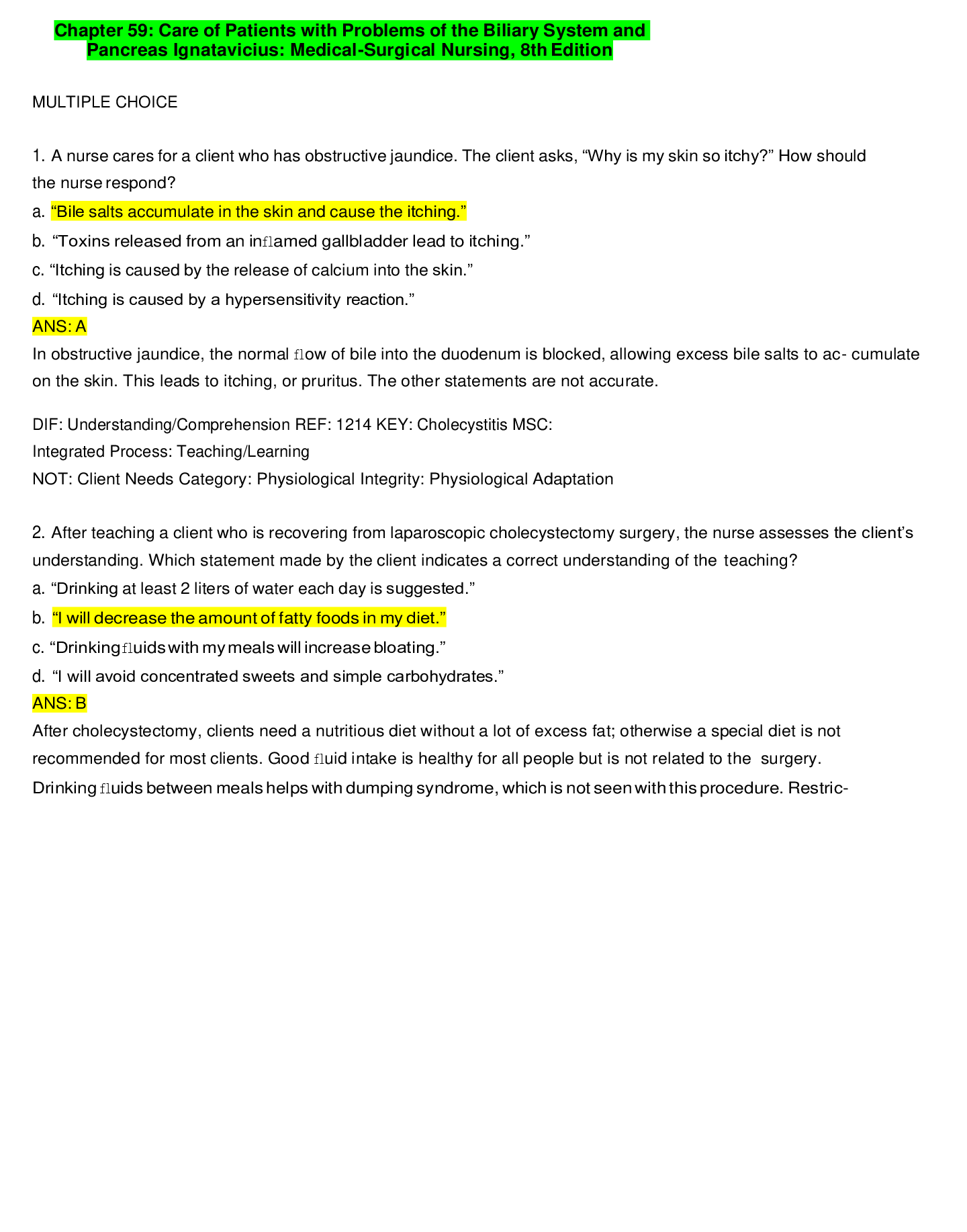
.png)
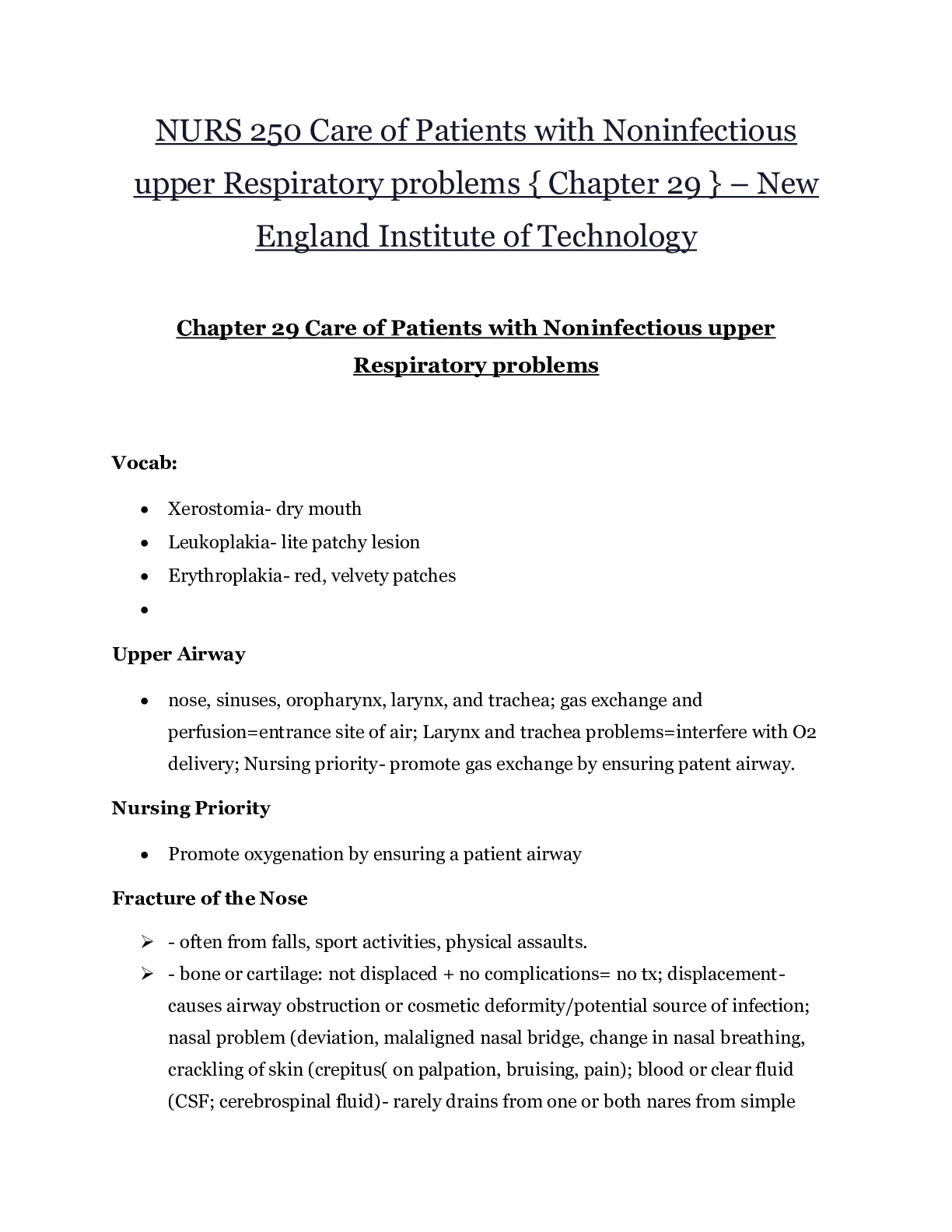
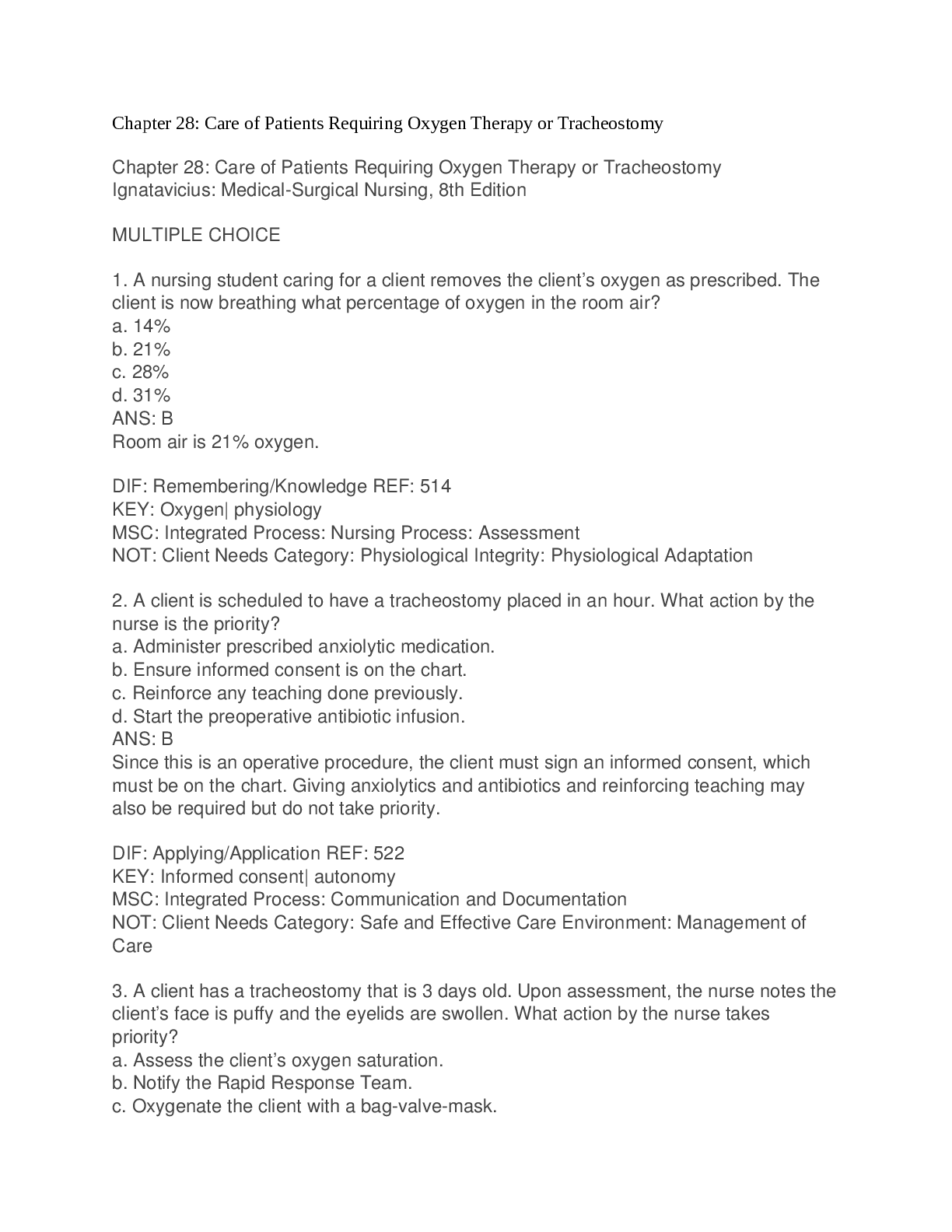
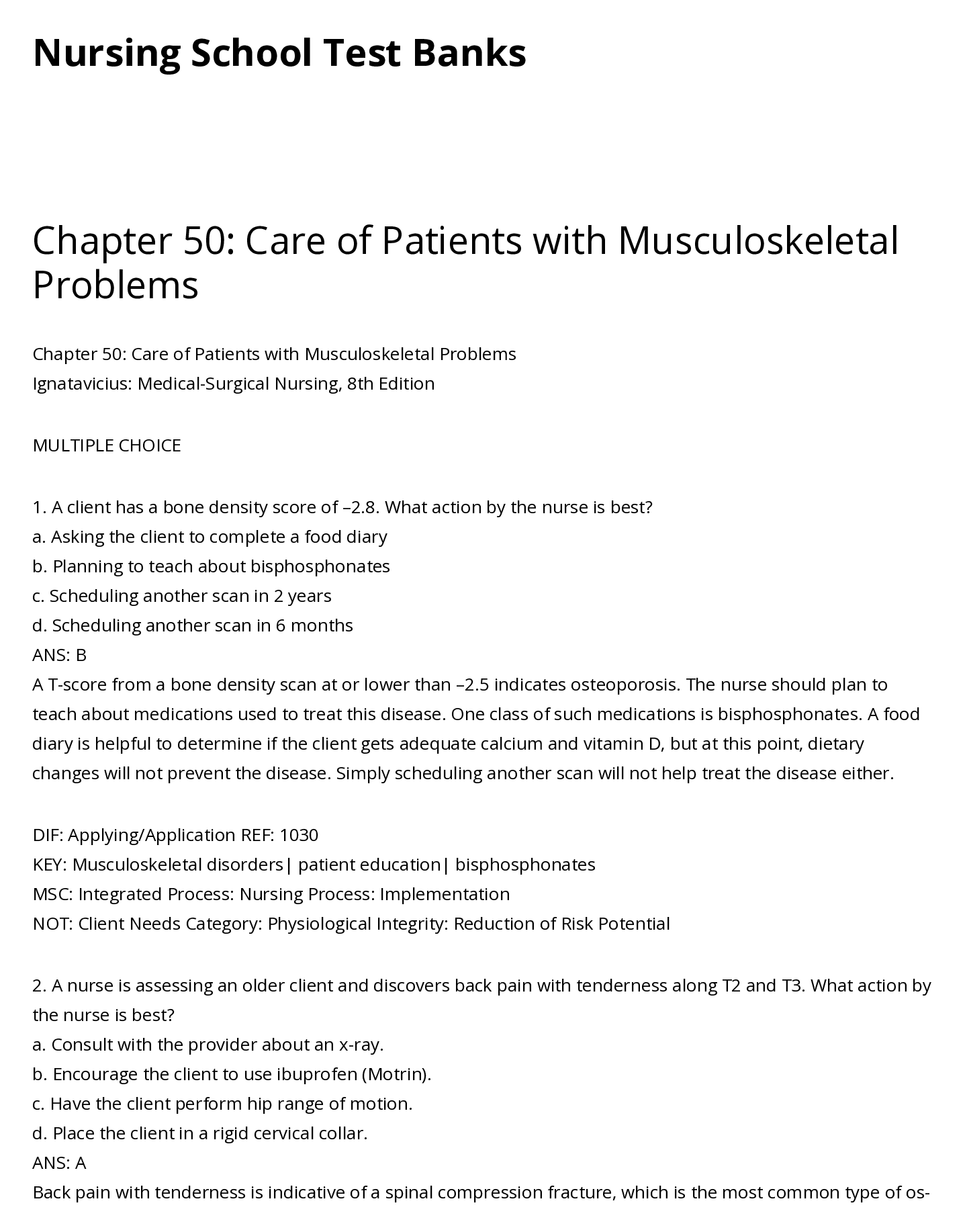
.png)

